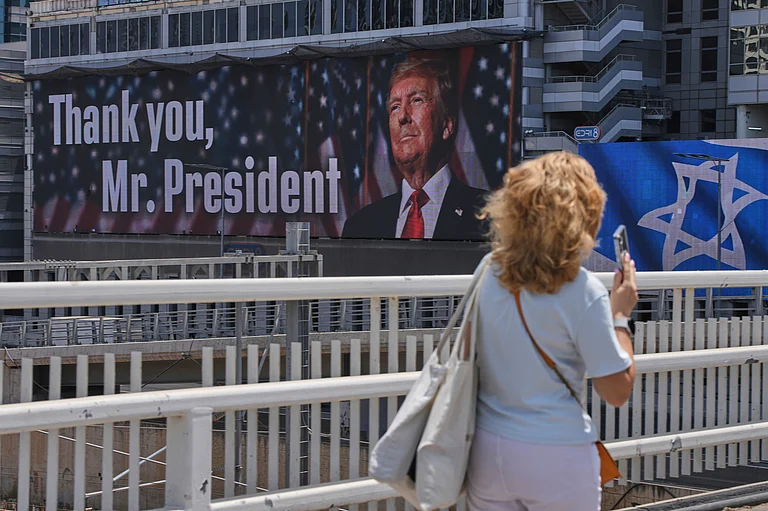Tensions in West Asia have reached a significant point after Israel vowed to respond to Iranian missile strikes carried out on Tuesday. These developments have raised concerns about a wider conflict in a region already marked by instability and volatility. Israeli officials have indicated that they intend to make Iran "pay" for the attacks, which has fueled fears of a military escalation.
Speculation now surrounds the possible targets of Israeli military action. Some analysts suggest that Israel may consider striking Iranian oil fields or nuclear facilities as part of its response strategy. The situation has become more complicated due to the stance taken by the United States, which has a close alliance with Israel. The U.S. government has called on Tel Aviv to avoid targeting Iran’s nuclear sites in particular, urging restraint in the face of escalating tensions. Despite these calls for caution, a senior official from the U.S. State Department informed CNN that Israel has not provided any assurances that it will follow the advice.
The issue gained further prominence when U.S. President Joe Biden addressed the situation earlier this week. Biden stated that he would not endorse an Israeli military strike against Iran’s nuclear program. He noted that if he were in Israel's position, he would be considering alternative strategies rather than focusing on an attack on oil fields.
Former President Donald Trump, who is currently campaigning for the 2024 Republican presidential nomination, expressed a different viewpoint during a recent campaign event in North Carolina. Trump indicated that he believes Israel should target Iran’s nuclear facilities in retaliation for the missile strikes. His comments came in response to a question directed at President Biden about the possibility of military action against Iran. Trump stated that he thought Biden’s response was inadequate, suggesting that the primary focus should be on Iran's nuclear capabilities. He stated that if Iran poses a significant threat, then targeting its nuclear sites should be a priority.
The growing speculation surrounding a potential Israeli military strike on Iran has prompted discussions about timing. Some observers have noted that an operation could occur around October 7, which marks the anniversary of Hamas' 2023 attack on Israel.
Iran's nuclear facilities are dispersed across several locations, with some constructed in underground bunkers to enhance protection from potential airstrikes. The situation surrounding Iran's nuclear program has been a source of contention for years, leading to a series of diplomatic efforts aimed at curbing its activities. The United States and the United Nations nuclear watchdog believe that Iran had a covert nuclear weapons program that was halted in 2003. Iran has consistently denied ever having pursued such a program.
The 2015 nuclear deal, formally known as the Joint Comprehensive Plan of Action (JCPOA), was established to restrict Iran’s nuclear activities in exchange for relief from international sanctions. However, the agreement began to unravel after then-President Trump withdrew the United States from the deal in 2018. Following this withdrawal, Iran began abandoning the restrictions set forth in the agreement, leading to increased concerns about its nuclear ambitions.
Reports suggest that Iran now possesses a supply of highly enriched uranium that could potentially be converted into weapons-grade fuel for at least three nuclear bombs. According to The Washington Post, Iran has the capability to construct a crude nuclear device within six months, but it would take longer to develop a missile-deliverable warhead. Iran's enrichment activities have reached levels of up to 60 per cent fissile purity at two of its nuclear sites, which is perilously close to the 90 percent threshold required for weapons-grade uranium. The International Atomic Energy Agency (IAEA) has indicated that Iran has enough material enriched to this level, which could theoretically be further processed to produce nearly four nuclear bombs.
Overview of Iran’s Nuclear Sites
Several key sites in Iran are central to its nuclear program, and they have become focal points in discussions about potential Israeli military action. Here is an overview of some of these critical facilities:
Natanz: Natanz is Iran’s primary uranium enrichment facility, located about 300 kilometres south of Tehran in the Isfahan province. It features two main enrichment plants: the underground Fuel Enrichment Plant (FEP) and the above-ground Pilot Fuel Enrichment Plant (PFEP). This site became known in 2002 when an exiled Iranian opposition group disclosed its existence, leading to a diplomatic standoff over Iran's nuclear intentions. Natanz houses numerous centrifuges for uranium enrichment, which could be utilized for both civilian and military applications. The site has been targeted multiple times, and Iran has accused Israel of being behind these attacks.
Fordow: Situated near Qom, Fordow is another significant enrichment site built into a mountain, providing additional protection from potential aerial bombardments. The facility was secretly constructed over several years, and its existence was revealed in 2009. Currently, Fordow operates over 1,000 centrifuges, including advanced IR-6 machines that enrich uranium to 60 per cent. The 2015 nuclear agreement prohibited Iran from enriching uranium at Fordow, but the facility is now fully operational with an increased number of centrifuges.
Isfahan: This site includes a major nuclear technology centre on the outskirts of Isfahan, Iran’s second-largest city. It encompasses the Fuel Plate Fabrication Plant (FPFP) and the uranium conversion facility (UCF), both of which play crucial roles in the nuclear fuel cycle. The UCF can convert uranium into uranium hexafluoride, which is used in centrifuges for enrichment. The IAEA has reported the presence of equipment at Isfahan for producing uranium metal, which is a sensitive issue due to its potential military applications.
Khondab: Formerly known as Arak, the Khondab facility is a heavy-water research reactor. Heavy-water reactors pose a proliferation risk because they can produce plutonium, which can be used to create nuclear weapons. Under the 2015 nuclear deal, construction on Khondab was halted, and measures were taken to render the reactor unusable. However, Iran has communicated its intentions to bring the reactor online in 2026.
Tehran Research Centre: This facility includes a research reactor and a site for producing medical radioisotopes used in cancer treatment. While the centre primarily serves civilian purposes, the potential for military use exists if highly enriched uranium were utilized in its operations.
Bushehr: The Bushehr plant is Iran’s only operational nuclear power plant and is located on the Gulf Coast. It operates using Russian-supplied fuel, which is returned to Russia after use, minimizing the risk of nuclear proliferation. The facility is intended for electricity generation and does not serve military objectives.
Karaj: This facility focuses on research in nuclear technologies related to agriculture and medicine. However, it can also be used to develop centrifuges for uranium enrichment. In 2021, Iran accused Israel of conducting an attack on a building at this site that belonged to the Atomic Energy Organization of Iran.
Saghand: The Saghand uranium mine is situated in Yazd province and began operations in 2013. The mine extracts low-grade uranium ore, which is then processed into purer uranium, known as yellowcake, at a nearby facility in Ardakan.
Parchin: Parchin is a military base that is suspected of being used to test conventional weapons and missiles. The IAEA has previously raised concerns about activities at Parchin, suggesting that Iran may have conducted tests related to explosive triggers that could be used in nuclear weapons.




























